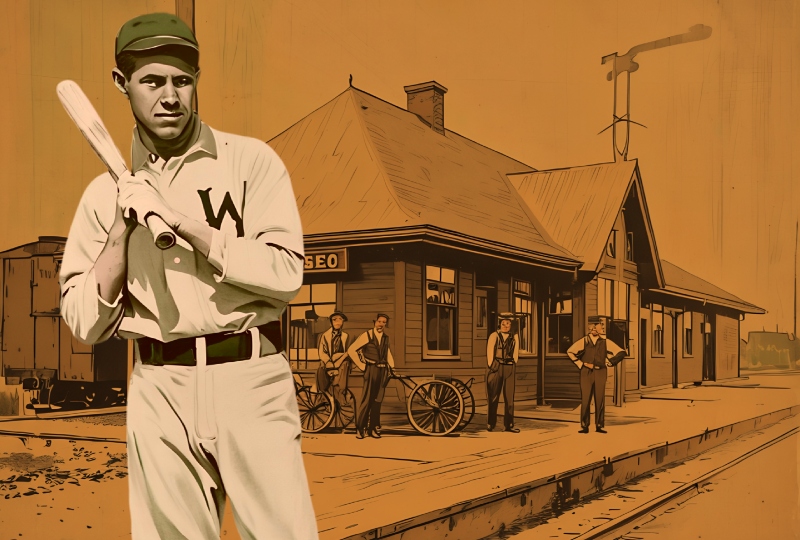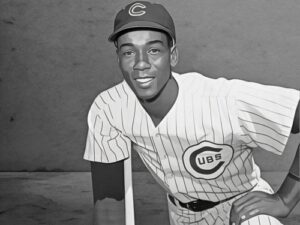Ed Delahanty’s success on the diamond obscured a troubled personal life marred by gambling and booze. His debts frequently mounted to the point that “Big Ed” would threaten suicide in the hopes that his teammates would bail him out; at times, even his mother followed him on road trips to make sure her son wouldn’t kill himself.
In 16 years in professional baseball, Delahanty showed himself to be one of the greatest batters in the game. He hit .400 three times and displayed the ability to do everything on the ball field: hit for power, hit for average, field, throw, and run.
By 1903, the 35-year old batting star had a slew of problems. He owed money in nearly every town on the major rail stops in the country. His drinking was spiraling out of control. And his wife was unhappy with him because of his womanizing. To compound it, Delahanty wanted out of his contract with Washington, a contract that he felt paid him too little to play in the fledgling American League, a circuit he saw as inferior.
On the night of July 2, 1903, Delahanty found a chance to escape his contract with the Washington club. A judge in New York ruled that shortstop George Davis, who had been under contract with the White Sox, could rejoin the Giants in the National League. Delahanty, hoping to be afforded the same opportunity, abandoned his teammates and boarded a train traveling from Detroit to New York. He planned to speak to league officials to convince them to set him free.
Eight hours and five shots of whiskey after boarding the train, Delahanty was asked to leave the locomotive. Loud and unruly, “Big Ed” had been a nuisance the entire journey, and when he attempted to drag a sleeping woman out of her berth by her ankles, the train conductor had decided enough was enough.
So it came to pass that Delahanty found himself standing on the Canadian side of the International Bridge with the bright lights of Buffalo ahead of him. “You’re in Canada,” he had been told by the conductor, “so don’t make any trouble.”
“I don’t care if I’m in Canada or dead,” Delahanty reportedly replied as he stormed away following the tracks. It was an eerily prescient response.
Later, the night watchman on the International Bridge, a man named Sam Kingston, found Delahanty leaning against one of the iron trusses. Kingston shined his lantern in Delahanty’s face; when Ed became belligerent, the watchman lunged at the stranger in an effort to subdue him. Delahanty ran, slipped on the tracks, and disappeared into the darkness. The next thing Kingston heard was a splash in the water some 20 feet below.
Several days passed before the stranger on the bridge was identified as Delahanty. Despite being able to hear Delahanty’s cries for help, Kingston failed to report the incident until early the next morning. The ensuing investigation turned up few leads. The only evidence as to the man’s identity was his hat, which he’d dropped on the bridge. Changes in Kingston’s story only complicated matters.
At first the newspapers were more concerned with the whereabouts of George Davis, whom Giants’ manager John McGraw was hiding from American League officials. The Senators, who had passed over the International Bridge less than an hour after Delahanty’s fall, were accustomed to Big Ed’s absences. Even Delahanty’s wife, Norine, was not terribly worried when he failed to meet her at the train station in New York.
When the story of Delahanty’s disappearance first broke, it was assumed that he was simply laid up somewhere with a headache and a bruised ego after a long bender. But as the days passed and repeated inquiries turned up nothing, the story started to come together.
The realization that Delahanty was the stranger on the bridge was finally made by John K. Bennett, manager for the Pullman Car Company, when he investigated the contents of a dress suitcase and black leather bag sitting unclaimed in his Buffalo office. He found a pair of high-top baseball shoes and a Washington Senators pass book.
On Thursday, July 9, a body was found floating in the swirling waters at the base of Niagara Falls by William LeBlond, operator of the popular Maid of the Mist tour boat. The connection between Delahanty and the International Bridge incident was now well known, and M.A. Green, a stockholder in the Senators, came from Buffalo to inspect the body. The corpse was terribly disfigured and most of the clothing had been torn off by the fierce waters, but Green was able to determine that the dead man was indeed Ed Delahanty.
Within hours, Frank Delahanty, Ed’s younger brother and an outfielder for Syracuse in the International League, arrived to observe the body. He questioned how Ed’s tie could be in place, yet his diamond rings had disappeared. Conducting further investigations of his own, he never could accept Kingston’s story.
Frank refused to see how the septuagenarian Kingston had come out on top in a scuffle with the “King of Swat,” and even though Kingston asserted that the stranger had wielded a lump of coal as a weapon, there was no coal in the vicinity of the bridge. To add to the intrigue, LeBlond found the body of a local farmer under the same waterfall shortly afterwards, minus 1,500 dollars he had been carrying when he left home.
The mystery of what happened to Ed Delahanty on his never-completed trip from Detroit to New York was never solved. An angry Frank Delahanty told reporters, “I have some suspicion about how Ed went off that bridge. The poor fellow is dead now, and he can never tell his side of the story, but the others can tell just what they please.”
Frank and others close to Ed were convinced that Delahanty’s opposition to the new American League had made him enemies. Those enemies may have wanted to silence Big Ed before he could poison other players against the new league.
Blame for Ed’s death was placed alternately on the railroad company, AL president Ban Johnson, John McGraw and Giants owner John Brush (apparently for having given Delahanty hope that he could jump to their team).
Ultimately, it was Delahanty’s own drinking, gambling and suicidal tendencies that were found guilty, at least by most people. A subsequent lawsuit by a destitute and heartbroken Norine Delahanty provided her with $5,000 from the railroad company. But the money couldn’t bring Big Ed back, and for Frank and others who didn’t accept the official story of Ed’s death, the tragedy would always feel suspicious.
A few days after his body was fished from the falls, the “King of Batters” was laid to rest in his hometown of Cleveland. Each of his four ballplaying brothers attended, and numerous friends from baseball came to pay their respects. John McGraw served as a pallbearer.
In 1945, the Veteran’s Committee voted Delahanty into the Hall of Fame; a career .346 hitter, he is the only player ever to win both an AL and NL batting title.
He might also be the only batting champion to be murdered.






